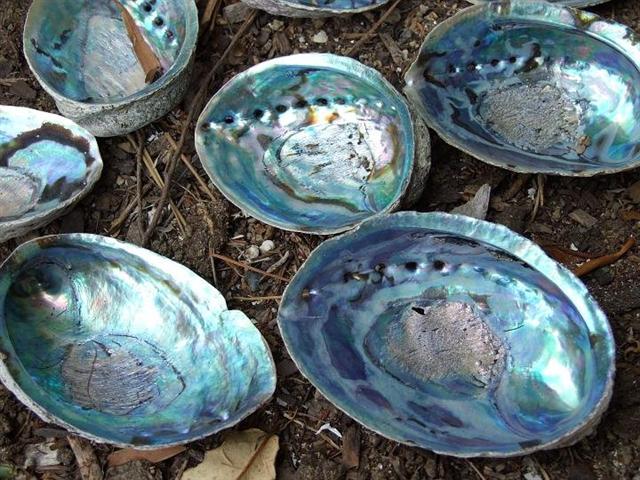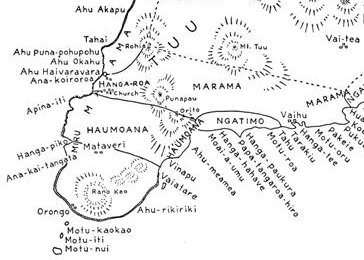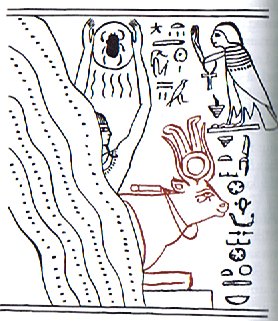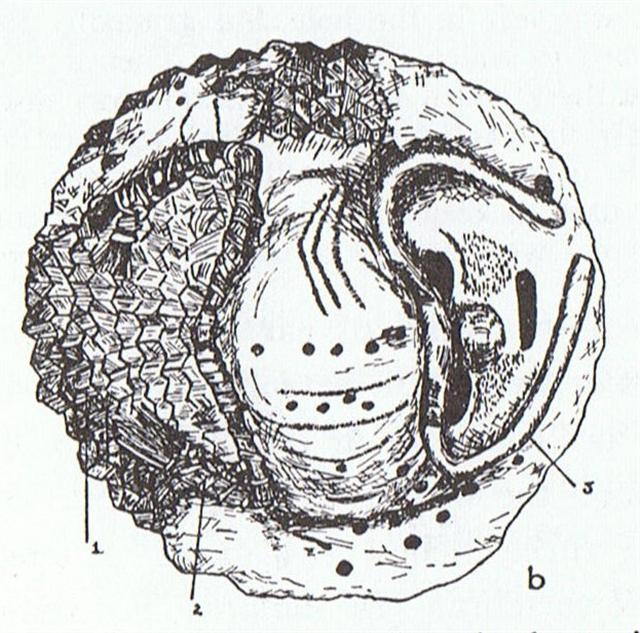Ira told his 5 companions to go out on the sea and 'behave like turtles' (= surfing on the waves), keeping them busy while he himself remained on the shore and started to drill holes. This complicated story should here be repeated: ... It grew light, and again Ira spoke. This is what he said: 'Turn around, all of you, and go down to ride the waves (literally, 'to the turtle, to act like a turtle').' Five of them went down; only Ira did not go down to let himself be carried on a board by a wave. After the young kinsmen had gone down to surf, Ira got up, picked up the mat with the treasure, unfolded the mat, pulled out the mother-of-pearl ornament (reipa), folded the mat again tightly, and left it on the ground. Ira got up, climbed up, went on, and reached Ruhi Hepii. He drilled a hole into the stone. After the hole was deep enough, he took the ornament (rei) and put it into the hole so that the shiny side (rapa) was turned outward. He gave the place the name 'Ruhi Hepii'. He turned around, climbed down, went on, and entered the cave Pu Pakakina. When he arrived there, he sat down. The young kinsmen arrived and rested. It grew light. On the second day, Ira said again, 'Go back to riding the waves!' They all went back out there. [In order to count this day as number 2 we cannot count the earlier mentioned 'another day dawned' as the same kind of day. Therefore 'another day dawned' could possibly refer to the 'dawn of the year', to the southern summer. This special 'day' is similar to the year before the first birthday. When a great cog in the wheel of time moves one step ahead all the smaller cogs should stand still.] Ira got up and again picked up the (second) ornament. He took it, went on, came to Apina Nui, drilled a hole into the stone, put the ornament in the hole, with the shiny side to the outside, and gave (the place) the name 'Pu'. He turned around, went on, and came to the cave Pu Pakakina. There he lay down [not sat down as in the previous day]. The young kinsmen arrived and also lay down. It grew light on the third day, and again Ira said, 'Go back to swimming on a board, to riding the waves!' All went back out there, and Ira got up. He picked up two stone figures (moai maea) and two mother-of-pearl necklaces (tuitui reipa). The name of the first stone figure was Apina Iti, and the second one was Rapa Kura. Ira took the figures and the ornaments, went on, and came to Apina Iti. He dug a pit, let the figure slide down into the pit, and covered it up with pebbles (kirikiri). The head remained completely free (? he puoko i hakapaka). [I guess there could be a double meaning alluding to 'completely dried out', which seeds should always be before planting.] He put the necklace around the neck of the figure and called the place 'Apina Iti A Rapa Kura' ... Ira gave the stone figure [earlier named Apina Iti] the name 'Hinariru', the name of the master, (son) of Tuu Hokorua, who had given the figure to Ira. He turned around, went on, and entered the cave Pu Pakakina and remained there. All the young men arrived and settled down (to sleep). It grew light on the fourth day, and they all got up (together). They climbed down, went on, and arrived at the bay. They hurried, went into the water, and reached the islet (off the shore). The wave began to move, and they all rode the wave (literally, 'they turned their lower body into the position of a turtle'). Ira rode the waves toward the right side. He looked diagonally toward the land, looked in the direction of Ruhi Hepii, and the ornament of Ruhu Hepii shone brightly. [I suspected Ruhu was Barthel's misspelling of Ruhi and looked in the Polynesian original. To my surprise - I guess Barthel could have used Ruhu as a Sign - the original text is: he ui mai a ruhi hepii he rapa atu te rei.mai ruhi hePii. Possibly we should read hePii as a reference to π and to November 10, where we can count 9 * 10 = 90.] He went back out into the sea, and the movement of the wave was to the left side. Again he glanced, this time in the direction of Pu, and the ornament of Pu shone brightly. [Pu was the name of the place with a hole in the stone at Apina Nui. Maybe Pi(i) was meant to be the opposite of Pu, as when right is contrasted with left.] Again he went out into the sea. From the middle, the two necklaces around the neck of the two figurines shone (toward him). His ride on the wave ended in Rio, and therefore the name 'Hanga O Rio' was given. [There were 2 necklaces, but the story recounts only how one of them was used around the neck of the stone figure Apina Iti. The other stone figure was Rapa Kura and nothing is said if also this figure was buried up to her neck or not. Instead the name of the Apina Iti figure was strangely changed to Apina Iti A Rapa Kura. If Barthel has translated the story correct, then it contains puzzles to solve. Was the Apina Iti statue joined to the Rapa Kura statue when he got the necklace around his neck? But then the name changed again, this time to Hinariru, the son of Tuu Hokorua, where indeed the latter name is in harmony with my question - 'in a group of two'.] Ira remained on shore, pondered, and said, 'This is well done! Ruhi to the right, Pu to the left, and Hinariru Nui and Hinariru Iti in the middle.' ... I will not here venture to unravel the details of this mythic story. However, we can make a table:
There could be a wordplay involved, with a pair of ra ('sun') stars enclosing (pa) the central 'pearlshell fishook':
The pair of holes with shining objects could have represented a pair of 'leading' stars, similar to those which once upon a time marked the tips of the horns of Taurus. In between was then the important point (tara) from where spring opened up (<).
After having completed his dangerous task Perseus raised 3 altars and sacrificed:
Zeus received a bull, Athene a cow, and Hermes a calf - sacrifices corresponding to the nature of these gods. Zeus was up above and Athene should be the Greek equivalent of Hathor, the Egyptian
The front legs of the rising Khepher looks like the horns of a bull. In between Hathor, reclining, and the rising 'insect' there is nothing visible - this is the 'opening', containing only air. Hermes should be here, it was his winged sandals which made it possible for Perseus to fly above the Sea Beast, tricking him with his shadow of the surface of the sea. ... On condition that, if he rescued her, she should be his wife and return to Greece with him, Perseus took to the air again, grasped his sickle and, diving murderously from above, beheaded the approaching monster, which was deceived by his shadow on the sea. He had drawn the Gorgon's head from the wallet, lest the Monster might look up, and now laid it face downwards on a bed of leaves and sea-weed (which immediately turned to coral), while he cleansed his hands of blood, raised three altars and sacrificed a calf, a cow, and a bull to Hermes, Athene, and Zeus respectively. Apina Iti could therefore represent such a spring opening, forcing apart the sky roof above and the flat earth below, creating room for the newborn year (the 'calf').
... It is a hat 'of plaited bulrush covered with painted tapa'. In the area marked 1 a part has been ripped off to show the plaiting below. The front part (right) is delineated by a kind of border the structure of which we recognize from that on the face of the sun god at Tiahuanaco. The eyebrow part of the border has a shape like viri. The right side is longer than the left. At the back of the hat there is a similar border, but here the ends are configured as Y, i.e. at the back side we find the female dark part. In the center there is a shell and possibly the creature is an insect. If we count the 'Y-tail' ends as 2 each we reach the sum 6 for the legs. The head of the creature is protruding in front of the shell, at the same time performing the function of a nose. On the left (female) side [of the shell] we see three wedge-formed lines (ribs?) as if to signal po, darkness. There are dots too on the shield, and maybe the insect is a lady-bug ... | |||||||||||||||||||||||||



